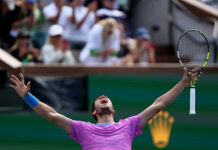
By John Huston
Sometimes the difference between victory and defeat is less than an inch. This was the case in the men’s final of the Sony Open. On championship point, at the very brink of a career-peak win, a too-hopeful David Ferrer dared to stop play, hoping that a forehand by Andy Murray was out. Shot Spot revealed that the ball had grazed the line. And with that, the momentum of the match switched decisively in Murray’s direction. A net cord winner gave the Scot an early mini-break in the third-set tiebreaker, and a few moments later, after a punishingly long rally in the Miami heat, Ferrer doubled over, fighting off leg cramps.
The evidence was there for all to see: Murray had ground down the ATP’s ultimate grinder. His 2-6, 6-4, 7-6 (1) triumph, bringing his total of Miami titles to two, was not a pretty one. But marked by a flurry of service breaks and a number of twenty-plus-shot rallies, it served notice as the men’s tour prepares for the clay swing that Murray is ready to vie for the Marathon Man status that the surface demands.
Ferrer’s game is one of walls. On the court, his anticipation, speed, and consistency combine in a manner that makes gimme-points a near-impossible ask for opponents. Yet it’s tempting to suggest that the soft-spoken Spaniard faces a bigger wall inside his mind. His loss to Murray brings his record in finals against tennis’ fab four—Djokovic, Murray, Federer and Nadal—to an unlucky 0-13. Facing the game’s very best, the man with the mighty return game suffers a crisis in confidence.
For Murray, his ninth ATP World Tour Masters Title was a textbook case of winning ugly. Rather than rely on shotmaking variety, the increasingly muscular 25-year-old made physicality and endurance the focus of his game plan, a tough ask against the tireless—or so it seemed— Ferrer. As coach Ivan Lendl looked on stone-faced behind a pair of shades, Murray’s forehand deserted him in the first set, allowing his opponent to race to a 5-0 lead. From there, the match shifted to a battle defined by breaks of serve—in fact, it took seven games before a player (Ferrer) held in the decisive set. Though the athleticism required by some of the match’s pivotal points was breathtaking, the final stats weren’t pretty: both players’ unforced errors far outnumbered their winners.
Coupled with rumors that the event might shift over outright to clay in the future, the slow play in Key Biscayne led some ambassadors of the big serve to chime in with criticisms. “Conditions too slow,” Andy Roddick wrote on Twitter, adding that he thought they’d find Jimmy Hoffa before he’d ever witness Ferrer cramp. Joking that he’s looking forward to playing on clay because it’s “faster,” Ivo Karlovic concurred: “Court and balls in Miami too slow to play entertaining tennis. There is no winners, just unforced errors.”
Though hampered by the absence of Roger Federer and Rafael Nadal, the men’s side of the the Sony Open still brought its share of drama, particularly the career renaissance of 34-year-old Tommy Haas, whose 6-2, 6-4 dispatch of top seed Novak Djokovic in the 4th round contested Roddick’s and Karlovic’s claims, proving canny net play and baseline aggression can still decide matches at the tournament. In an early-round loss, Paris Masters 1000 runner-up Jerzy Janowicz lost his cool more than once in the face of Thomaz Bellucci’s rowdy Brazilian fanbase, prompting Janowicz to write a lengthy post-match Facebook explanation of his actions.
But in the end, Miami belonged to Murray, who replaces Federer at number two in the
ATP rankings with a victory on the court that is his chief practice space in the U.S. “It was centimeters away from being [Ferrer’s] match,” he observed afterward. “It’s taking a little while to sink in. What I did do was fight hard [and show] good mental strength, because it easily could have slipped away from me.”
Both the men’s and the women’s Sony Open finals were three-set affairs. And for a little while, it looked like it might happen: Maria Sharapova might beat Serena Williams. Up a set, Sharapova stormed back from a break deficit in the second, executing a game plan that found her redirecting Serena’s shots with great success and even picking on Serena’s fearsome forehand. But it was not to be: Serena began to zone, and when Serena is in the zone, no one on the WTA Tour—even the powerful Sharapova—can touch her. In what seemed like a matter of instants, a fierce contest gave way to a rout, with Serena reeling off the last 10 games to notch a 4-6, 6-3, 6-0 victory. It was Serena’s eleventh win in a row against Sharapova.
It goes without saying that Miami is Serena’s home away from the slams now. Her win on Saturday brings her total of Miami titles to six, more than any other women’s player, and with her 6-0, 6-3 dismissal of Agnieszka Radwanska in the semifinals, she surpassed Steffi Graf’s number of match wins at the tournament. “I finally have some record,” she said after the match. “I can’t seem to catch up with Margaret Court or Steffi [Graf, in overall records], so it’s exciting.”
While Serena for the most part did not bring her most dominant play to Miami, she did bring excitement. Exhibit one: Serena-as-Sybil versus Cibulkova. In the fourth round, against Slovakia’s diminutive Dominika Cibulkova, she found herself down 2-6, 1-4 but proceeded to win the next 11 games in a come-from-behind performance that presaged the final. “I’m talking to myself inside and she’s giving me lip,” Serena explained in the aftermath of that match. “I give her a little attitude, and then I tell her she sucks and she tells me to shut up. We get into it a little bit. And then we get along.”
If Serena has multiple personalities, she brought more forceful ones to her quarterfinal contest with Na Li and especially her semifinal encounter with Radwanska, where she executed five aces within one game, leaving her crafty opponent—who’d made perhaps the shot of the tournament, a miraculous 360-degree save volley, in the previous round—looking dejected and weaponless. But in the early stages against Sharapova, windy conditions left Serena without the high ace count she often uses to impose her will. Instead, she was frequently left catching the ball mid-toss in a manner reminiscent of her sister Venus.
Credit to Sharapova, though, for going toe-to-toe with Serena and at times even overpowering her for half of the three-set match. The 25-year-old world number two went into the final having won eleven successive matches in straight sets, and for a few minutes it looked like she might add Serena to the list. Though Serena eventually snapped Sharapova’s straight-set record, Sharapova did end one of Serena’s: going into the match, Serena had won twelve successive sets in their matchup. “It was a step in the right direction and there’s no doubt we’ll be playing many more times,” Sharapova said afterward. “There’s no doubt I’ll be able to beat her.” It was Sharapova’s fifth loss in the final of the tournament.
For her part, Serena exhibited her trademark mental resilience to prevail once again. With her back against the wall, she used her kick second serve to draw return errors from Sharapova, and began attacking Sharapova’s own serve with a success that introduced doubts and crucial double-faults into her opponent’s game. Though Sharapova’s coach Thomas Hogstedt gave her an extended on-court pep talk between the second and third sets, it did nothing to stop Serena’s momentum. “I feel like [Sharapova] lifted her level, and [made me ask], ‘Can I get better?’”, Serena said. “For me the answer is always yes. I just want to do the best that I can.”


















